Optimal Design and Dynamic Characteristic Analysis of Double-Link Trapezoidal Suspension for 3WPYZ High Gap Self-Propelled Sprayer
Abstract
1. Introduction
2. Materials and Methods
2.1. Design Requirements and Working Principle
2.2. Theoretical Analysis
2.2.1. Mathematical Model of the Boom Suspension
- (1)
- In this modeling, the boom suspension is treated as a rigid beam on the vertical plane, without considering the elastic deformation.
- (2)
- It is assumed that the integral boom suspension is well lubricated throughout, and the effect of frictional damping is not considered.
- (3)
- The mass of the individual connecting members is not considered.
- (4)
- Assuming that the ground inclination change is equal to the body inclination change, the vibration damping effect of the sprayer chassis suspension and tires is ignored.
2.2.2. Optimize the Establishment of Mathematical Model
2.2.3. Construction of 3D Model of Boom Suspension
2.3. Dynamic Characterization Simulation Test Process Based on ADAMS
2.4. Static Analysis Simulation Test Process Based on Ansys
2.5. Field Dynamic Characteristic Test Process
3. Results and Discussion
3.1. Dynamic Simulation Results and Analysis
3.1.1. Step Excitation Response Analysis
3.1.2. Sinusoidal Excitation Response Analysis
3.1.3. Virtual Trials of Boom Suspensions
- (1)
- Change the length of the inner boom suspension rod LAD
- (2)
- Change the length of the inner boom suspension rod LBC, LAB, and d
3.2. Static Simulation Results and Analysis
3.3. Field Performance Test Results and Analysis
4. Conclusions
- (1)
- Based on the D’Alembert principle and the principle of multibody dynamics, a kinematic model of a two-link trapezoidal boom suspension was established, and the design factors affecting the stability of the boom were determined through theoretical analysis.
- (2)
- The results of the multi-factor test based on Design-Expert show that, when the connecting rod length LAB was 265 mm, the inner boom suspension rod LAD was 840 mm, the outer boom suspension rod LBC was 1250 mm, and the throttle diameter d was 4 mm; the maximum swing angle of the nozzle suspension decreased by 53.02%, the natural frequency decreased from 1.3143 rad/s to 1.1826 rad/s, and the dynamic characteristics were significantly optimized.
- (3)
- After static optimization, the stress at the joint of the boom suspension was reduced to 22 MPa, the maximum displacement was reduced to 7 mm, and the maximum stress of the inner boom suspension was reduced to 88.07 MPa. The modal analysis results show that the optimized design of the boom suspension can effectively avoid the influence of external swing frequency on the stability of the suspension.
- (4)
- The angle between the hoist and the vertical direction increased first and then decreased, and the maximum swing angle of the suspension increased first and then decreased; the change range was about 0.2°, which proves that the mathematical model is reasonable. The maximum swing distance at the end of the 21 m boom was only 0.073 m, ensuring the stability of the pesticide application operation.
Author Contributions
Funding
Institutional Review Board Statement
Data Availability Statement
Conflicts of Interest
References
- Hu, Y.H.; Yang, H.B.; Hou, B.R.; Xi, Z.T.; Yang, Z.D. Influence of Spray Control Parameters on the Performance of an Air-Blast Sprayer. Agriculture 2022, 12, 1260. [Google Scholar] [CrossRef]
- He, X. Advances in high efficiency plant protection machinery and precision application technology. J. Plant Prot. 2022, 49, 389–397. (In Chinese) [Google Scholar]
- Feng, Y.N.; Pei, L.; Chen, X.; Chen, X.B.; Liu, Y.; Chen, B. Summary of the key technology of variable rate application. J. Chin. Agric. Mech. 2021, 42, 65–71. [Google Scholar]
- Luo, X.W.; Liao, J.; Hu, L. Improving agricultural mechanization level to promote agricultural sustainable development. Trans. Chin. Soc. Agric. Eng. 2016, 32, 1–11. (In Chinese) [Google Scholar]
- Li, W.; Yang, F.; Mao, E.R.; Shao, M.X.; Sui, H.C.; Du, Y.F. Design and Verification of Crab Steering System for High Clearance Self-Propelled Sprayer. Agriculture 2022, 12, 1893. [Google Scholar] [CrossRef]
- He, X. Research and development of crop protection machinery and chemical application technology in China. Chin. J. Pestic. Sci. 2019, 21, 921–930. [Google Scholar]
- Zhang, G. Research and Design of Four Wheel Steering System of High Clearance Self-Propelled Platform; Northwest A&F University: Yangling, China, 2016. [Google Scholar]
- Sartori, S.; Balthazar, J.M.; Pontes, B.R. Non-linear dynamics of a tower orchard sprayer based on an inverted pendulum model. Biosyst. Eng. 2009, 103, 417–426. [Google Scholar] [CrossRef]
- Cui, L.F.; Xue, X.Y.; Le, F.X. Adaptive robust precision control of an active spray boom suspension with disturbance estimation. J. Vib. Control 2021, 29, 3–4. [Google Scholar] [CrossRef]
- Han, J.H.; Park, C.H.; Jang, Y.Y.; Gu, J.D.; Kim, C.Y. Performance Evaluation of an Autonomously Driven Agricultural Vehicle in an Orchard Environment. Sensors 2022, 22, 114. [Google Scholar] [CrossRef]
- Li, W.; Xue, T.; Mao, E.; Du, Y.; Li, Z.; He, X. Design and Experiment of Multifunction Steeering System for High Clearance Self-propelled Sprayer. Trans. Chin. Soc. Agric. Mach. 2019, 50, 141–151. [Google Scholar]
- Lardoux, Y.; Sinfort, C.; Enfalt, P. Test method for boom suspension influence on spray distribution, Part I:experimental study of pesticide application under a moving boom original research article. Biosyst. Eng. 2007, 96, 29–39. [Google Scholar] [CrossRef][Green Version]
- Chen, S.R.; Han, H.Y.; Chen, G. Dynamic characteristic analysis and vibration reduction design for sprayer frame. Trans. Chin. Soc. Agric. Mach. 2013, 44, 50–53. (In Chinese) [Google Scholar]
- O’Sullivan, J.A. Verification of passive and active versions of a mathematical model of a pendulum spray boom suspension. J. Agric. Eng. Res. 1988, 40, 89–101. [Google Scholar] [CrossRef]
- Nation, H.J. The design and performance of a gimbal-type mounting for spraye rbooms 1. Development procedure. J. Agric. Eng. Res. 1987, 36, 233–246. [Google Scholar] [CrossRef]
- Frost, A.R. A design procedure for twin universal link spray boom suspensions. J. Agric. Eng. Res. 1987, 37, 179–189. [Google Scholar] [CrossRef]
- Qiu, B.J.; Yang, N.; Xu, X.C. Ideal spray boom response extraction with front and rear tires excited by step track. Trans. Chin. Soc. Agric. Mach. 2012, 43, 55–60. (In Chinese) [Google Scholar]
- Qiu, B.J.; He, Y.J.; Sheng, Y.H. Finite element modal analysis and structure optimization of spray boom. Trans. Chin. Soc. Agric. Mach. 2014, 45, 112–116. (In Chinese) [Google Scholar]
- Wu, J.L.; Miao, Y.B. Dynamic characteristic analysis of boom for wide sprayer with different exciting sources. Trans. Chin. Soc. Agric. Eng. 2012, 28, 39–44. (In Chinese) [Google Scholar]
- Cui, L.F.; Xue, X.Y.; Ding, S.M. Analysis and test of dynamic characteristics of large spraying boom and pendulum suspension damping system. Trans. Chin. Soc. Agric. Eng. 2017, 33, 61–68. (In Chinese) [Google Scholar]
- Cui, L.F.; Xue, X.Y.; Ding, S.M. Modeling and simulation of dynamic behavior of large spray boom with active and passive pendulum suspension. Trans. Chin. Soc. Agric. Mach. 2017, 48, 82–90. (In Chinese) [Google Scholar]
- Yang, F.; Du, Y.F.; Li, X.Y.; Zhang, Y.A.; Mao, E.R.; Li, Z. Multi-condition suspension control and test of large sprayer fused with pavement characteristics. Trans. Chin. Soc. Agric. Mach. 2023, 54, 110–120. (In Chinese) [Google Scholar]
- Chen, Y.; Mao, E.; Li, W.; Zhang, S.; Song, Z.; Yang, S.; Chen, J. Design and experiment of a high-clearance self-propelled sprayer chassis. Int. J. Agric. Biol. Eng. 2020, 13, 71–80. [Google Scholar] [CrossRef]
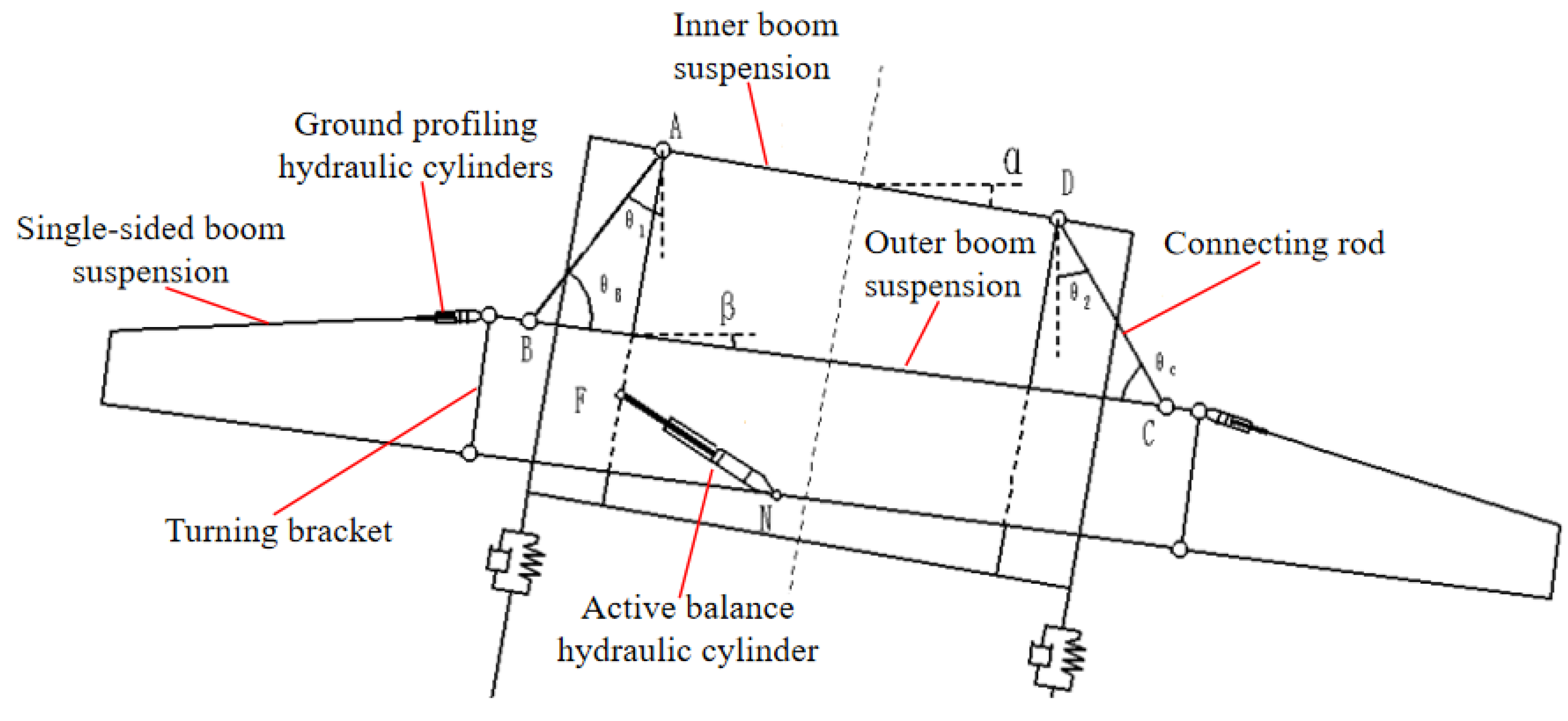
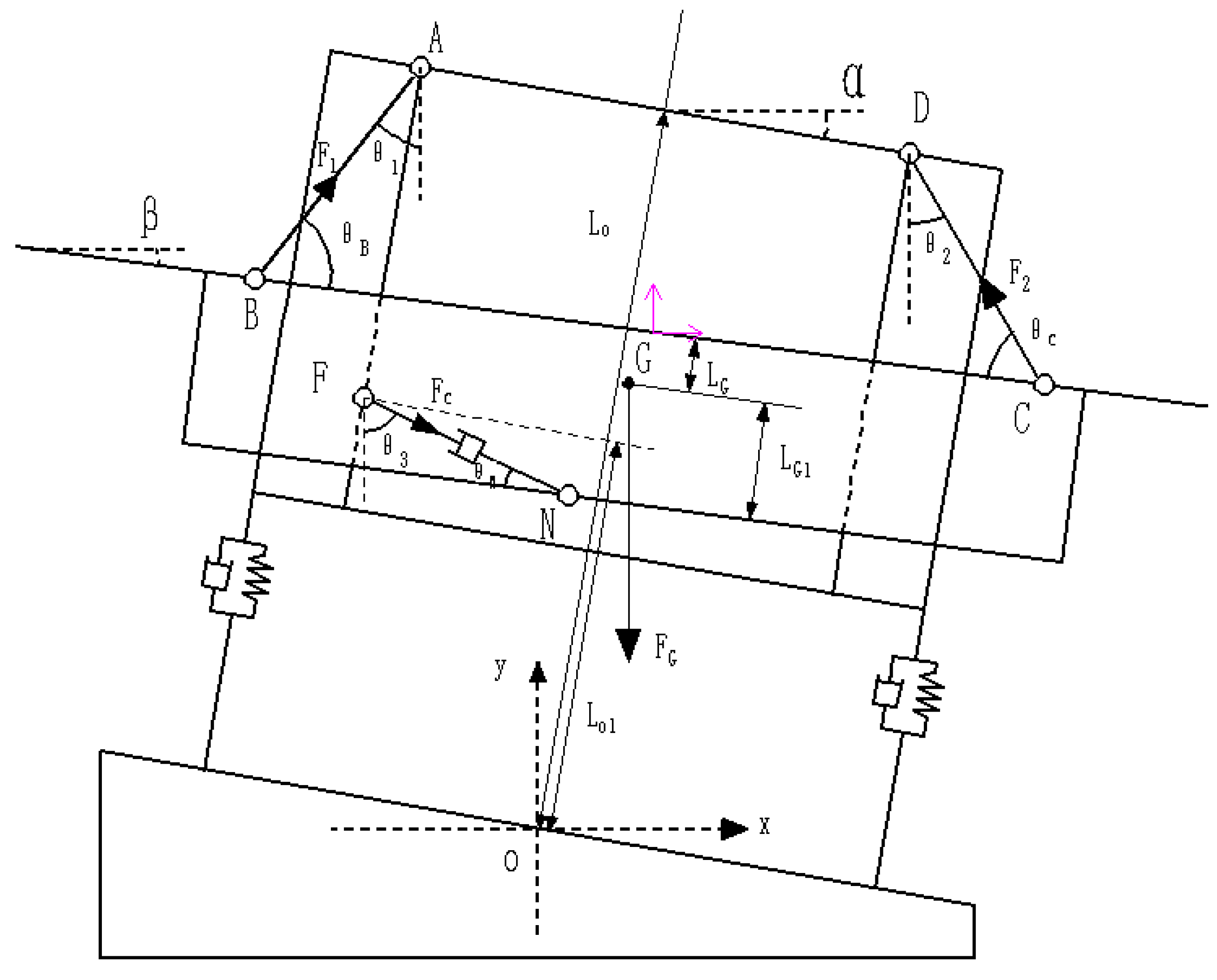
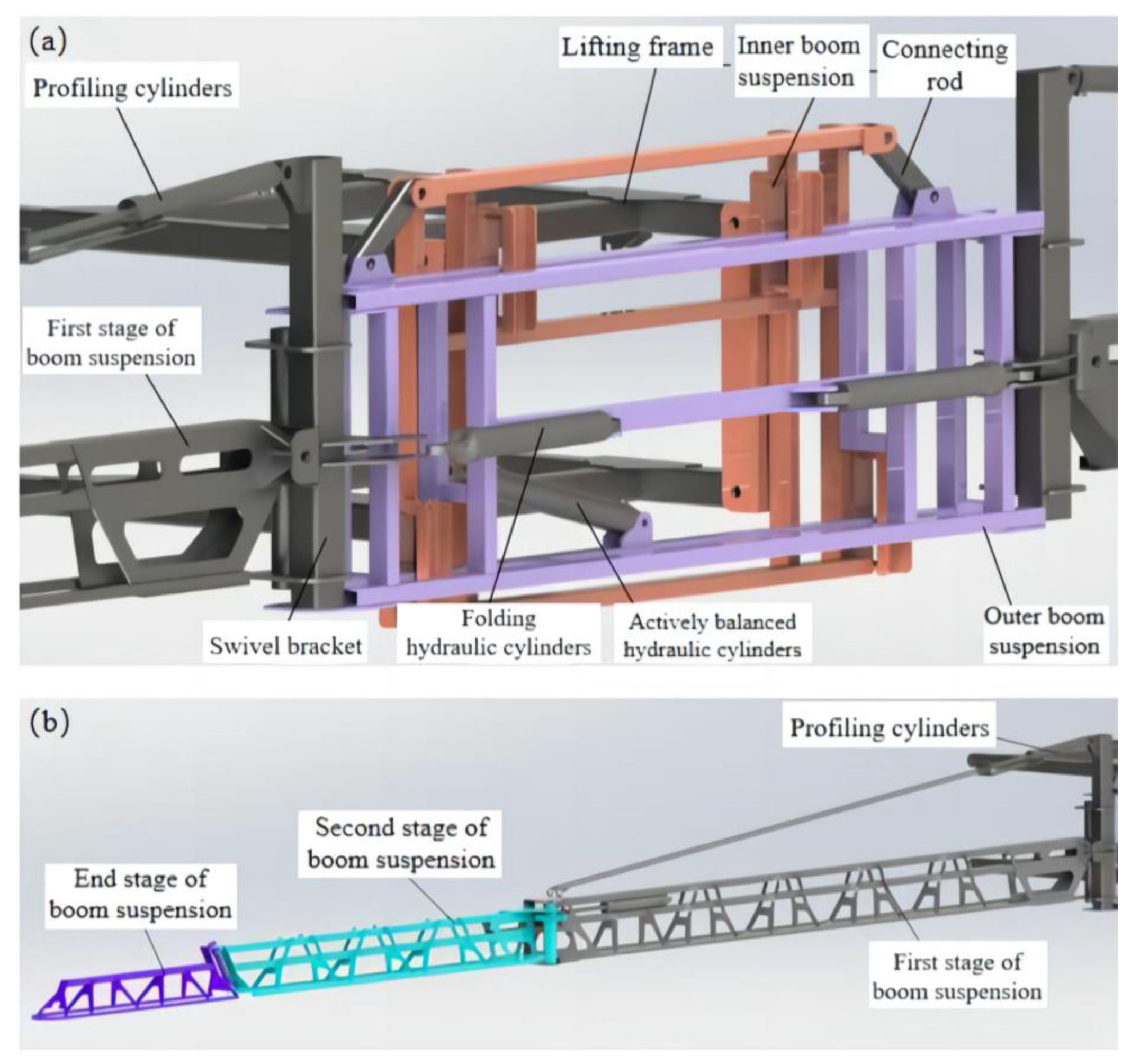
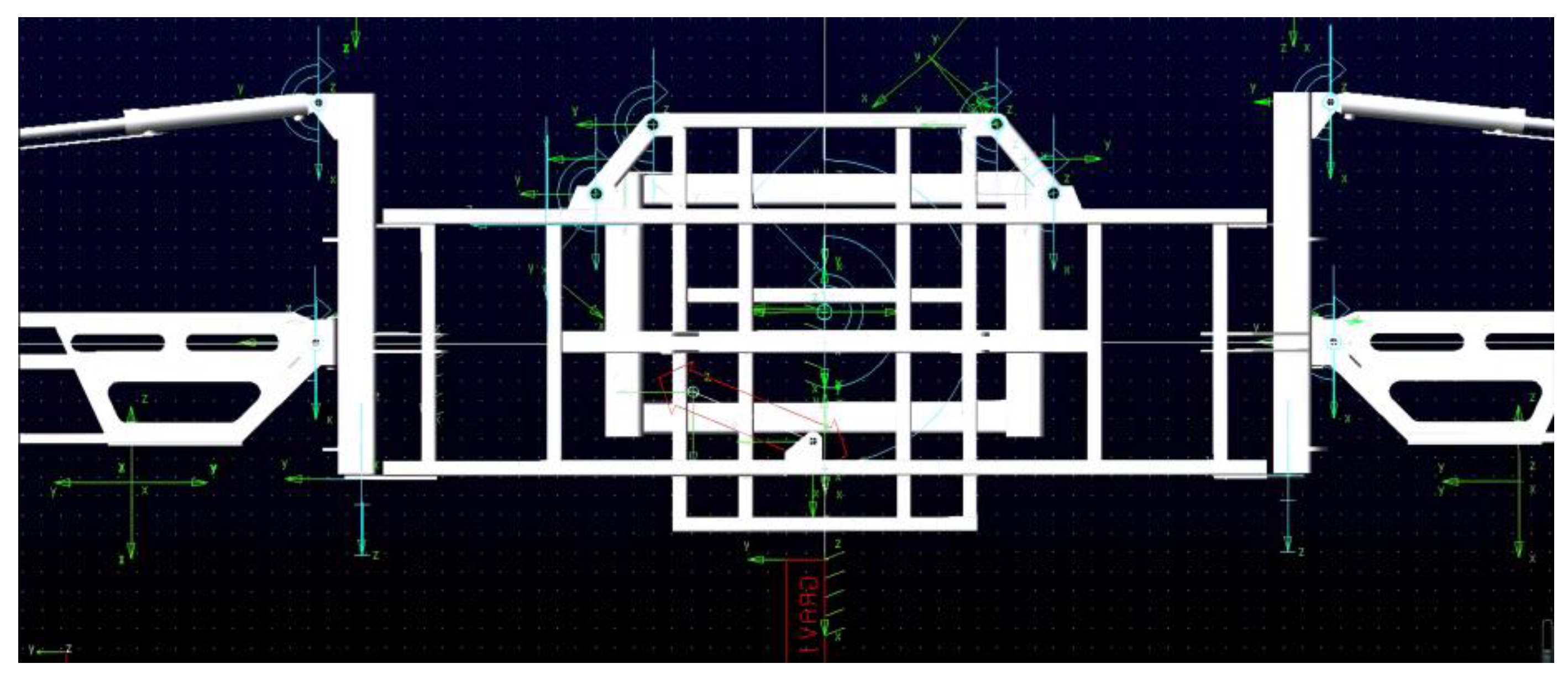

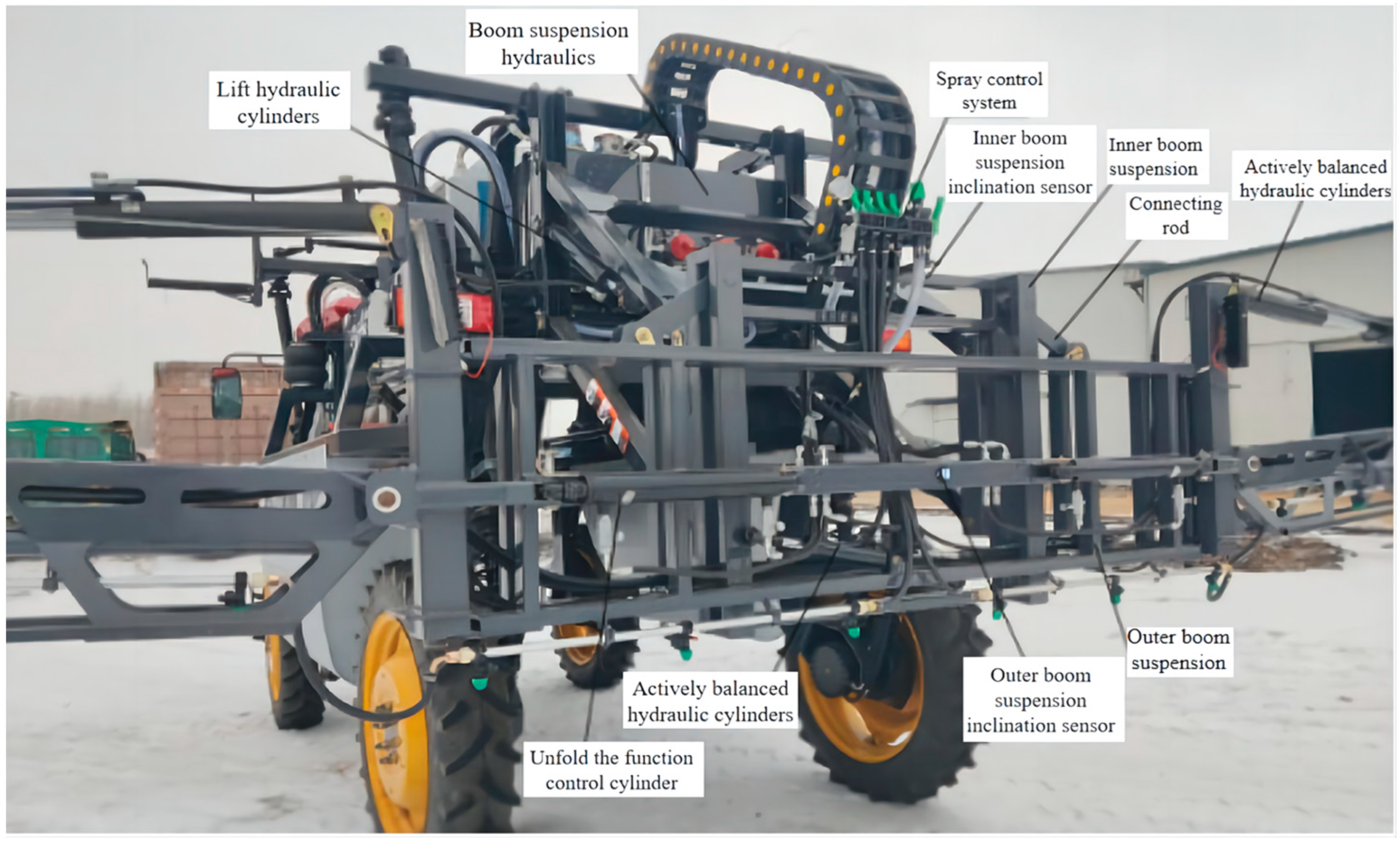
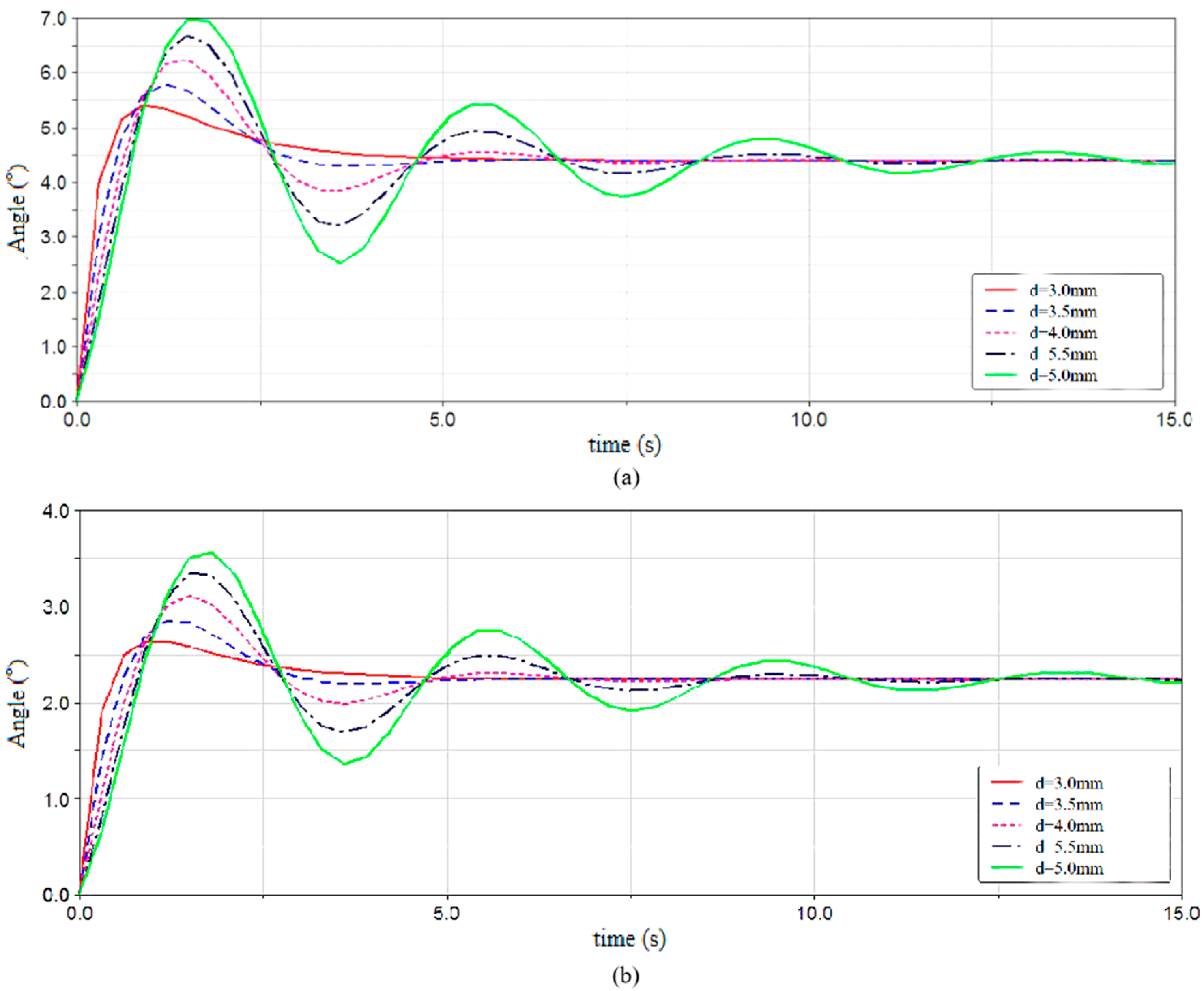
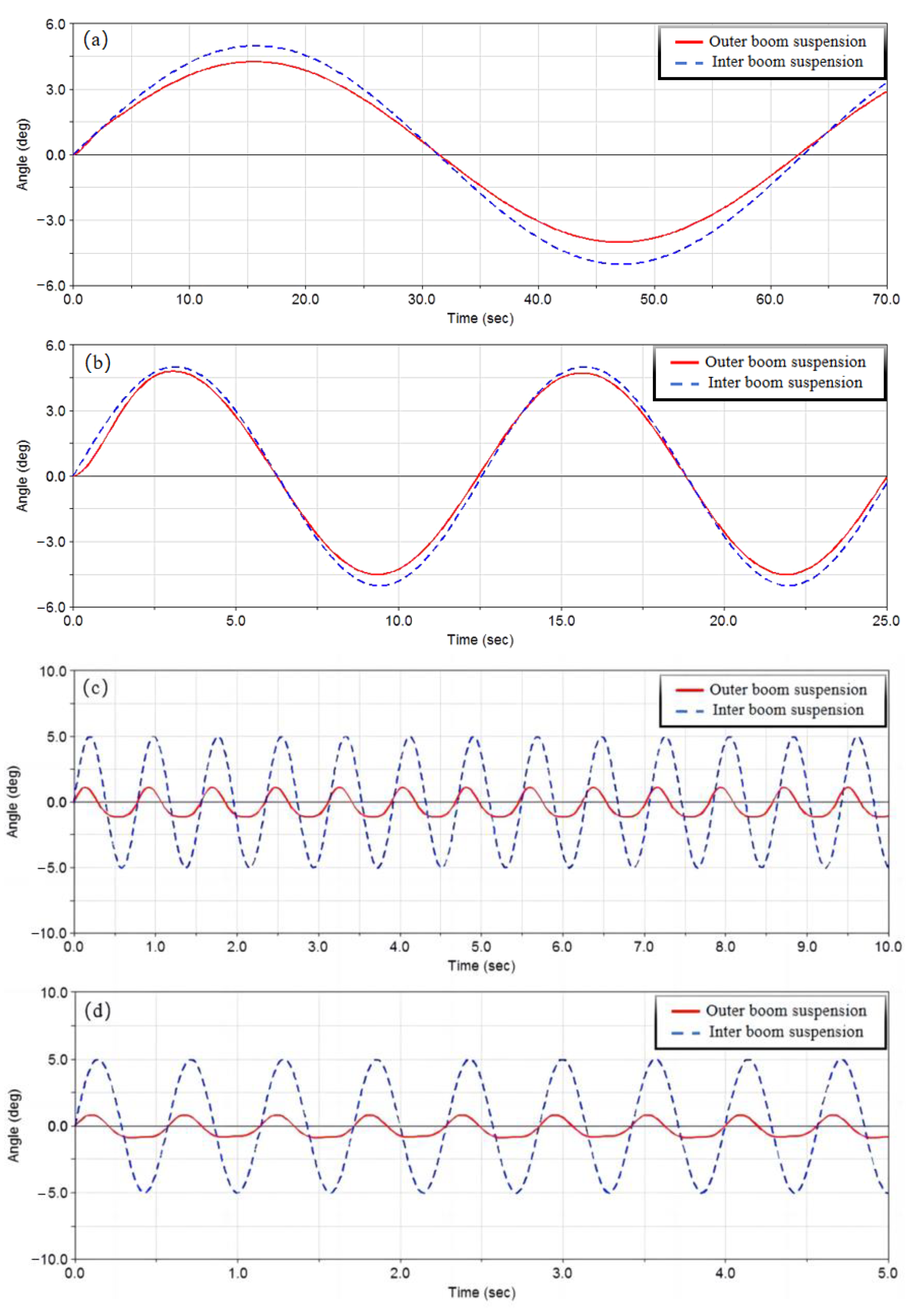
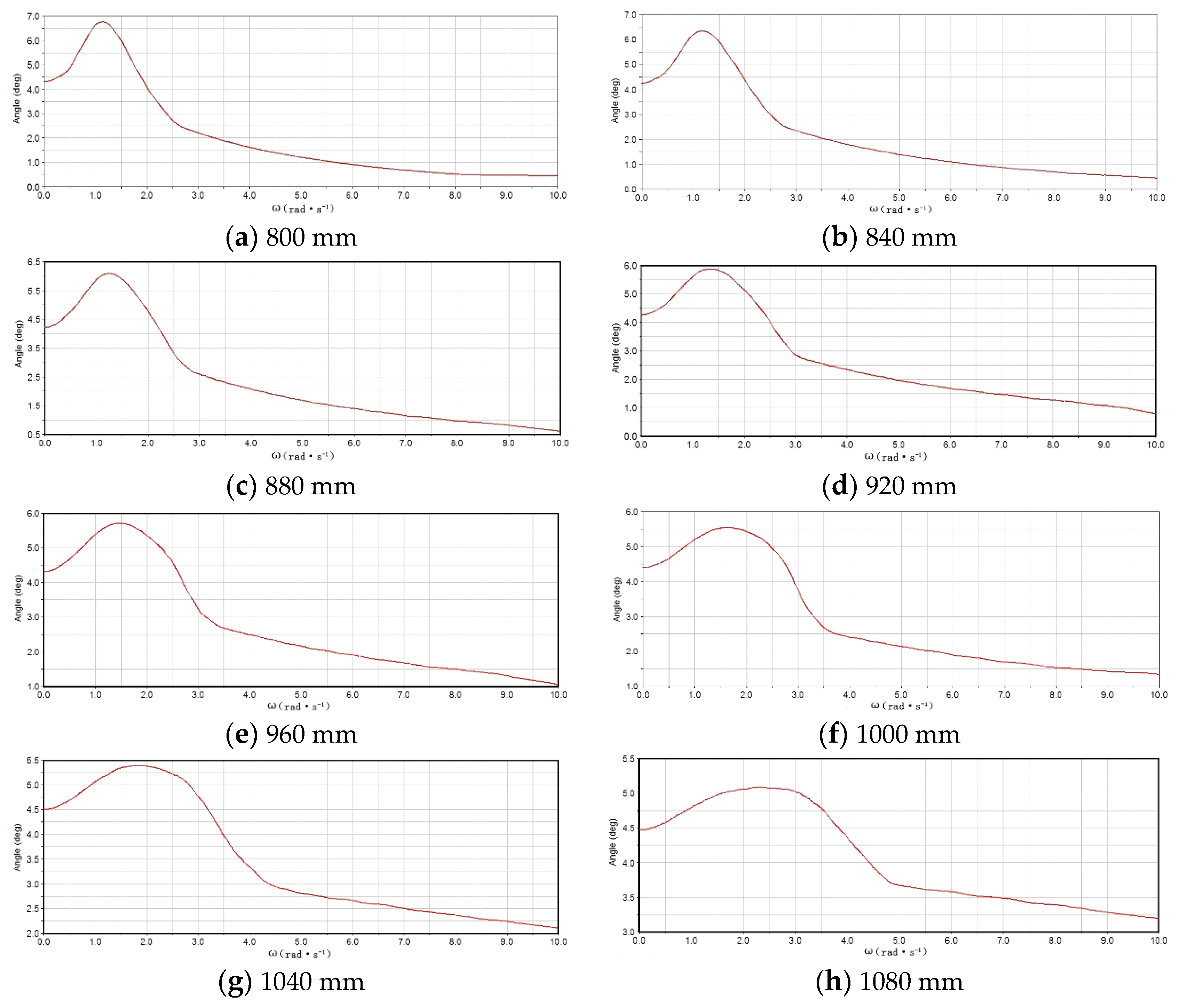
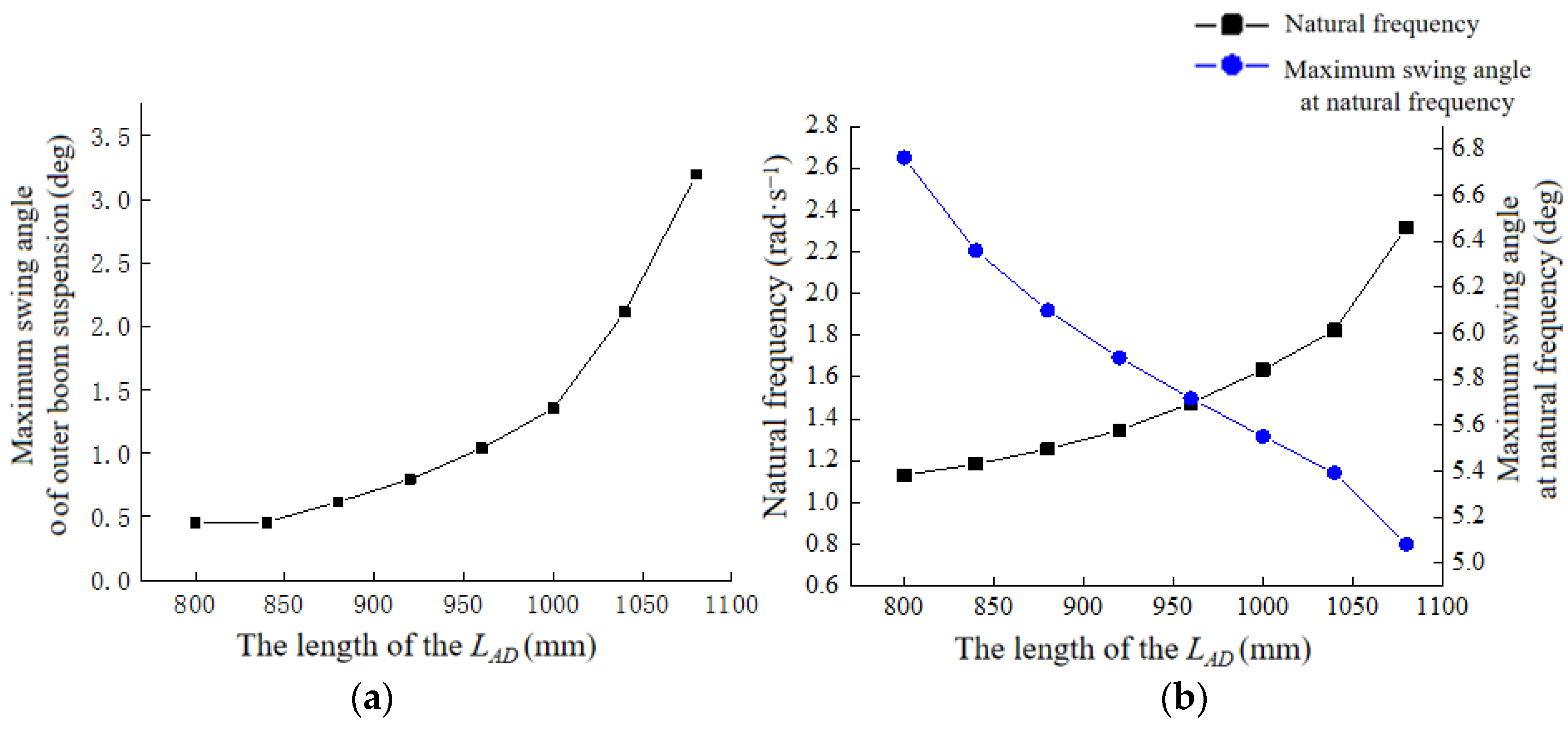
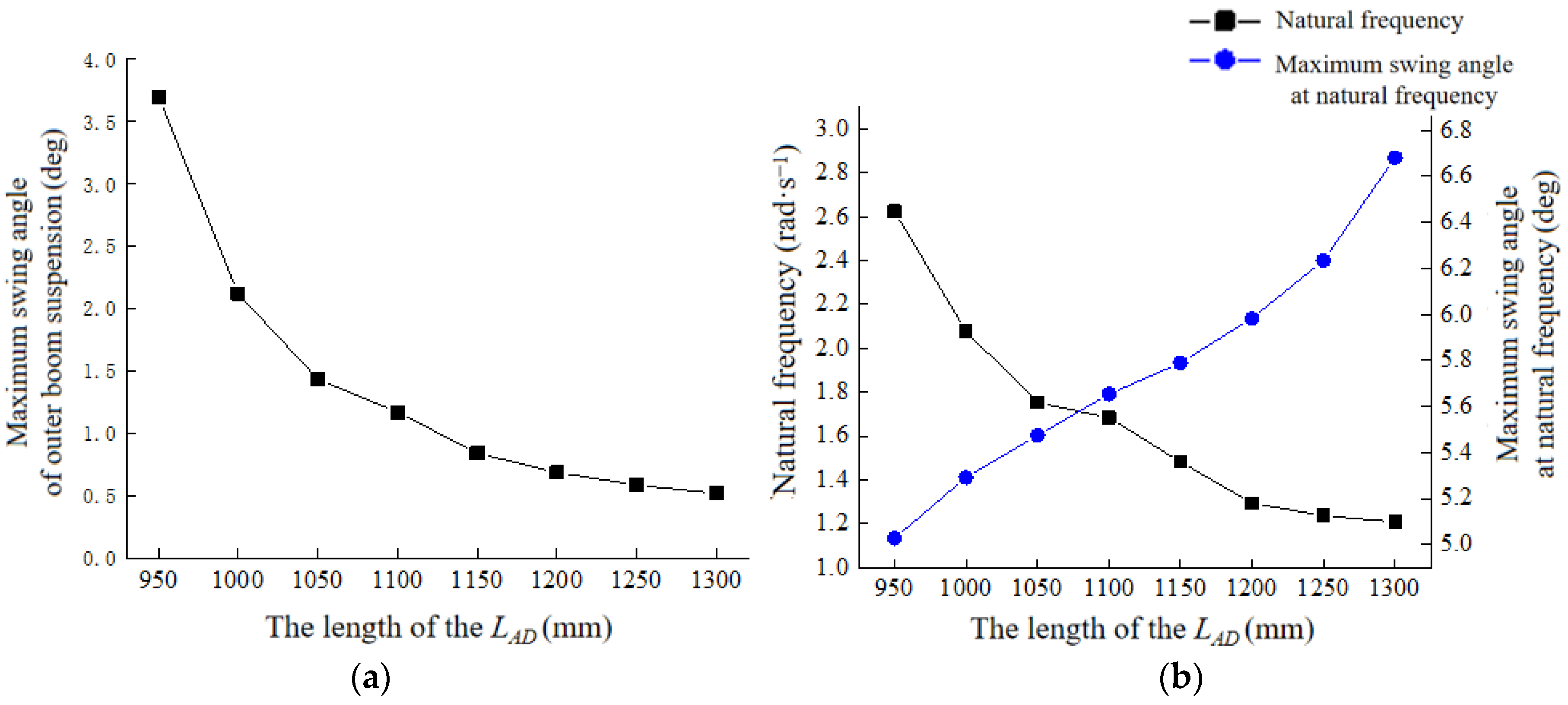

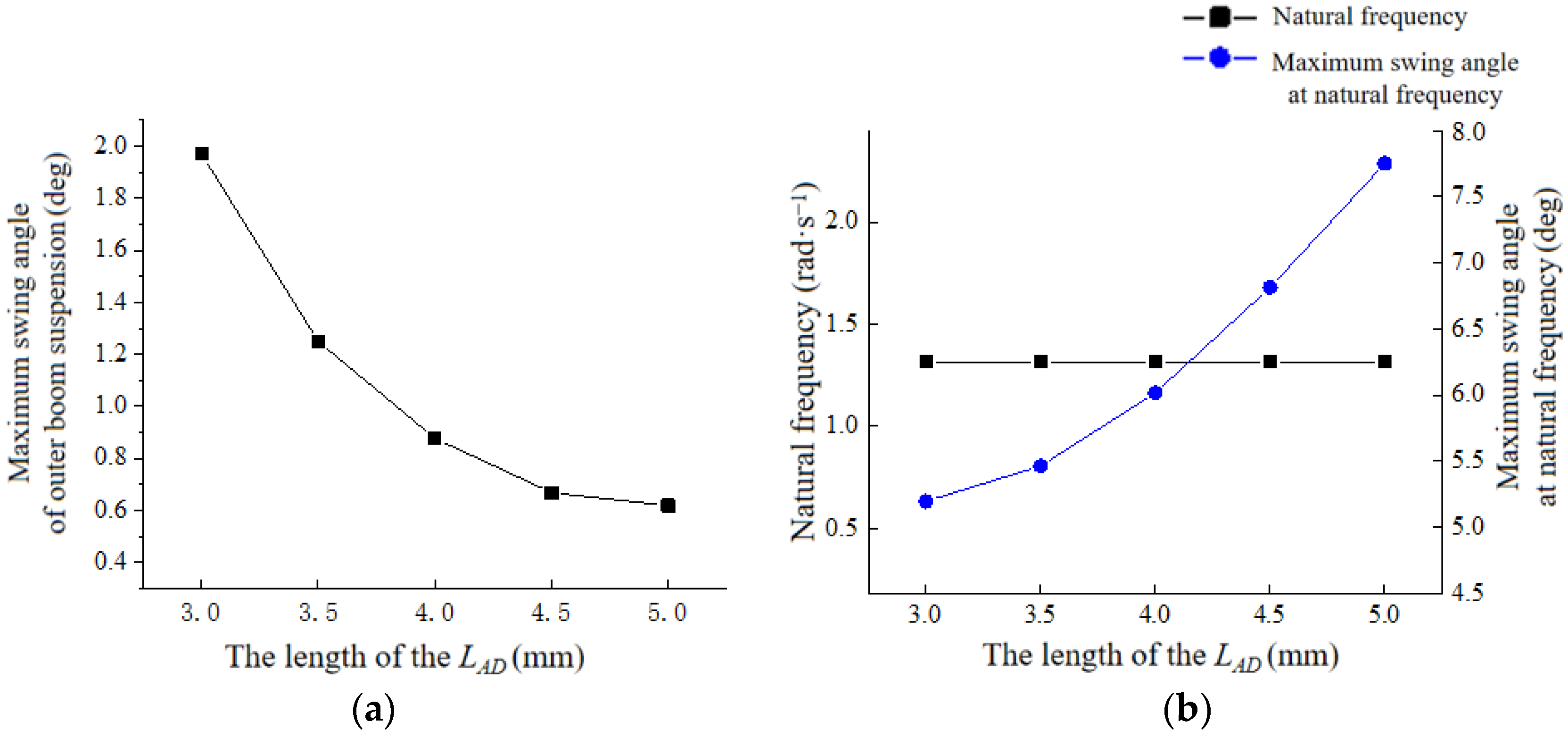
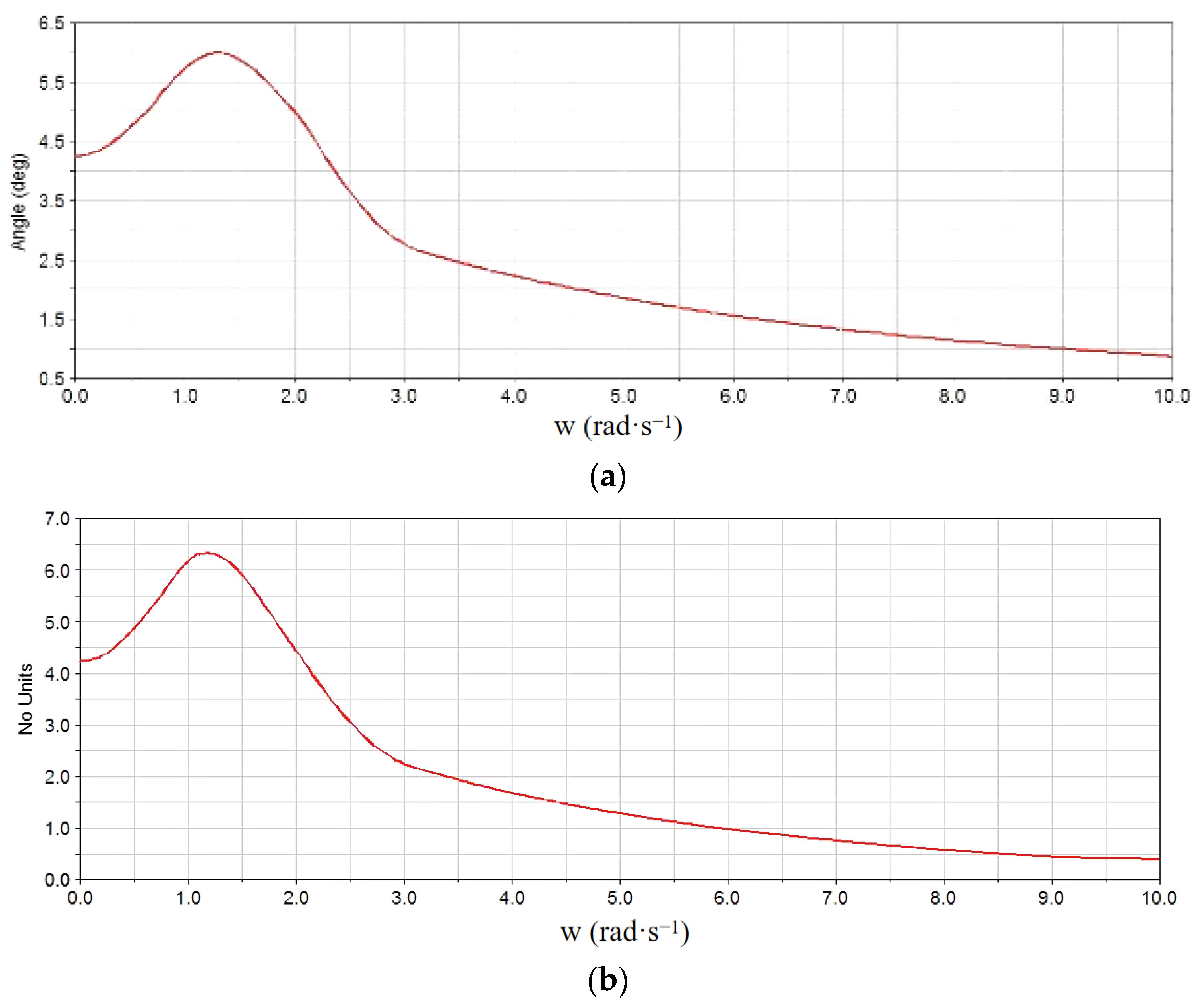
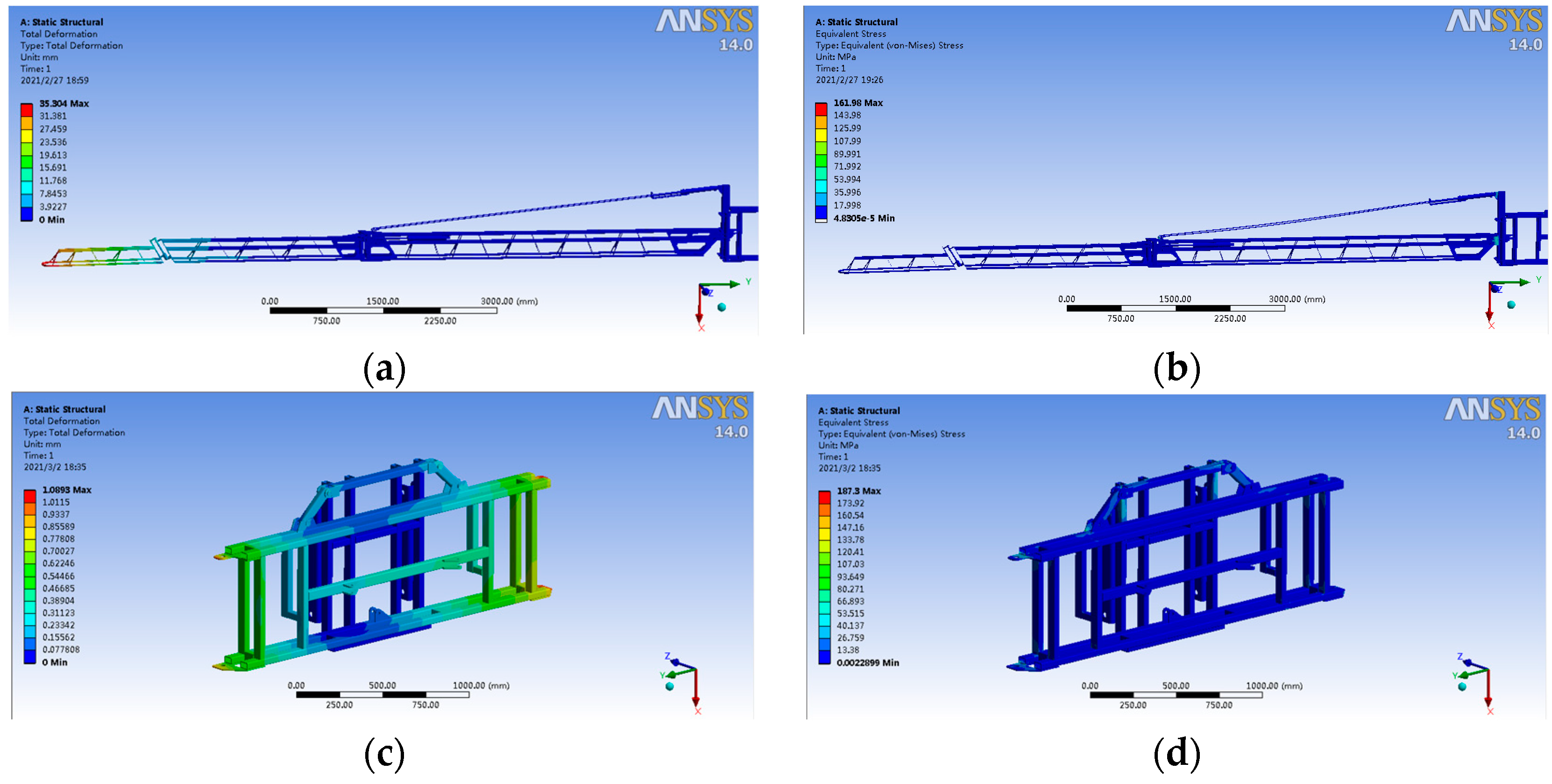

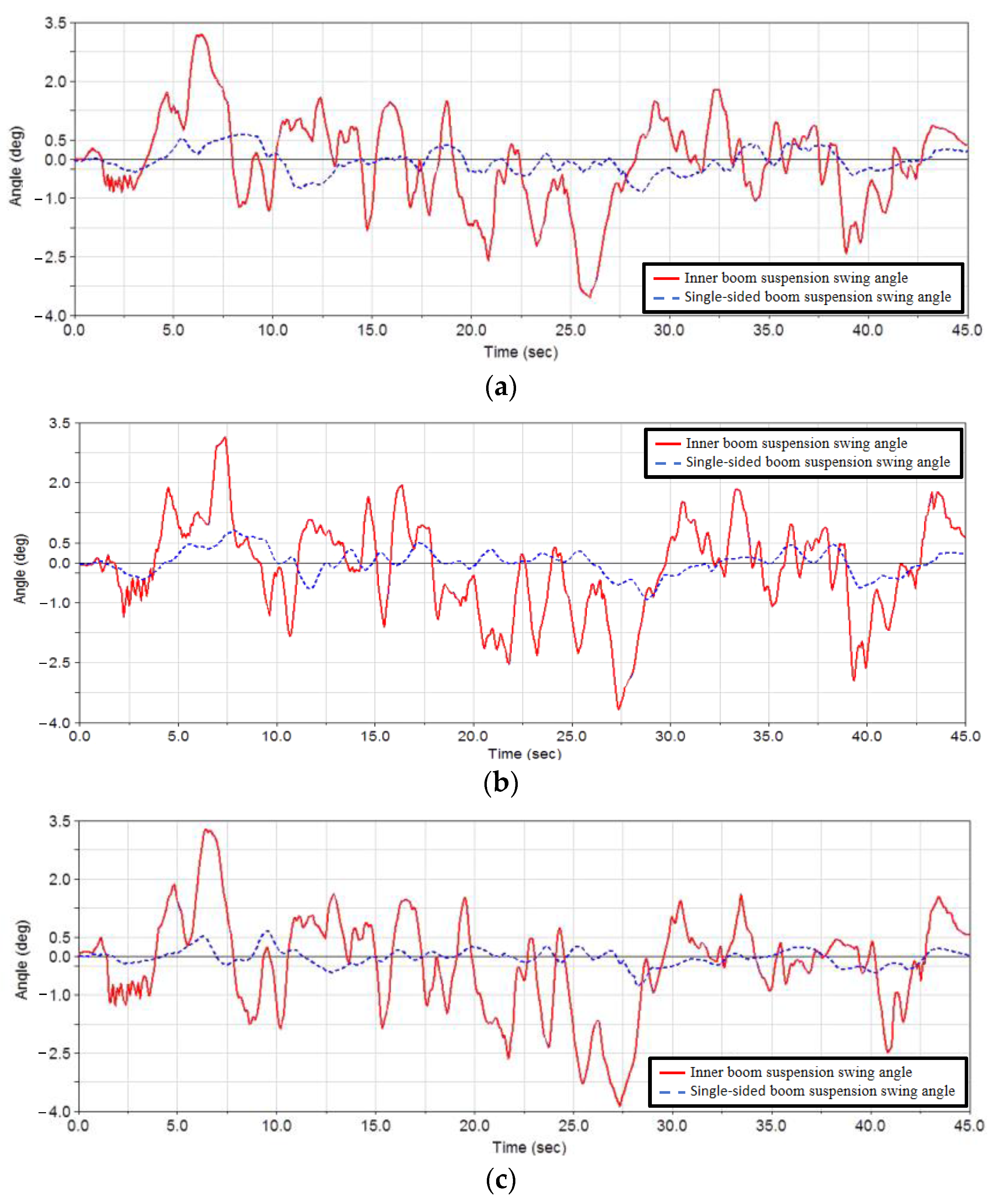
| Parameters | Values | Units |
|---|---|---|
| LAB | 270 | mm |
| LBC | 1180 | mm |
| LCD | 270 | mm |
| LAD | 860 | mm |
| LG | 314 | mm |
| 0.63 | rad | |
| IB | 9.89 × 109 | kg·mm2 |
| MB | 530.87 | kg |
| d | 4 | mm |
| Main Components | Section Shape | Section Shape Size (mm) | Wall Thickness (mm) |
|---|---|---|---|
| Inner boom suspension |  | 60 × 40 | 5 |
| Outer boom suspension |  | 60 × 40 | 5 |
| Turning brackets |  | 100 × 80 | 4 |
| First stage of boom suspension |  | 60 × 40 | 3 |
| Second stage of boom suspension |  | 60 × 40 | 2 |
| End stage of boom suspension |  | 20 × 20 | 2 |
| Level | Factor | |||
|---|---|---|---|---|
| LAB (mm) | LBC (mm) | LAD (mm) | d (mm) | |
| 1 | 220 | 1050 | 840 | 3 |
| 2 | 235 | 1100 | 880 | 3.5 |
| 3 | 250 | 1150 | 920 | 4 |
| 4 | 265 | 1200 | 960 | 4.5 |
| 5 | 280 | 1250 | 1000 | 5 |
| Level | LAB (mm) | LBC (mm) | LAD (mm) | d (mm) | E | F | Swing Angle (deg) | Natural Frequency (rad/s) |
|---|---|---|---|---|---|---|---|---|
| 1 | 220 | 1050 | 840 | 3 | 1 | 1 | 1.7069 | 1.29 |
| 2 | 220 | 1100 | 880 | 3.5 | 2 | 2 | 1.21835 | 1.3571 |
| 3 | 220 | 1150 | 920 | 4 | 3 | 3 | 0.8875 | 1.449 |
| 4 | 220 | 1200 | 960 | 4.5 | 4 | 4 | 0.71315 | 1.5061 |
| 5 | 220 | 1250 | 1000 | 5 | 5 | 5 | 0.6419 | 1.5143 |
| 6 | 235 | 1050 | 880 | 4 | 4 | 5 | 1.2148 | 1.6265 |
| 7 | 235 | 1100 | 920 | 4.5 | 5 | 1 | 0.9782 | 1.698 |
| 8 | 235 | 1150 | 960 | 5 | 1 | 2 | 0.8623 | 1.7082 |
| 9 | 235 | 1200 | 1000 | 3 | 2 | 3 | 2.3001 | 1.502 |
| 10 | 235 | 1250 | 840 | 3.5 | 3 | 4 | 0.6269 | 1.1204 |
| 11 | 250 | 1050 | 920 | 5 | 2 | 4 | 1.3423 | 2.2286 |
| 12 | 250 | 1100 | 960 | 3 | 3 | 5 | 3.031 | 1.7449 |
| 13 | 250 | 1150 | 1000 | 3.5 | 4 | 1 | 2.3038 | 1.8163 |
| 14 | 250 | 1200 | 840 | 4 | 5 | 2 | 0.5226 | 1.1816 |
| 15 | 250 | 1250 | 880 | 4.5 | 1 | 3 | 0.4165 | 1.2245 |
| 16 | 265 | 1050 | 960 | 3.5 | 5 | 3 | 3.3751 | 2.1878 |
| 17 | 265 | 1100 | 1000 | 4 | 1 | 4 | 2.6797 | 2.2795 |
| 18 | 265 | 1150 | 840 | 4.5 | 2 | 5 | 0.50275 | 1.2939 |
| 19 | 265 | 1200 | 880 | 5 | 3 | 1 | 0.46155 | 1.3147 |
| 20 | 265 | 1250 | 920 | 3 | 4 | 2 | 0.6502 | 1.7041 |
| 21 | 280 | 1050 | 1000 | 4.5 | 3 | 2 | 3.827 | 2.713 |
| 22 | 280 | 1100 | 840 | 5 | 4 | 3 | 0.5654 | 1.4163 |
| 23 | 280 | 1150 | 880 | 3 | 5 | 4 | 1.6828 | 1.519 |
| 24 | 280 | 1200 | 920 | 3.5 | 1 | 5 | 1.511 | 1.498 |
| 25 | 280 | 1250 | 960 | 4 | 2 | 1 | 0.9101 | 1.4265 |
| Category | Sum of Squares | Degree of Freedom | Mean Square | F | p |
|---|---|---|---|---|---|
| Model | 10.50 | 16 | 0.66 | 18.38 | 0.0001 ** |
| A-LAB | 0.35 | 4 | 0.087 | 2.45 | 0.1307 |
| B-LBC | 3.97 | 4 | 0.99 | 27.81 | <0.0001 ** |
| C-LAD | 3.59 | 4 | 0.90 | 25.18 | 0.0001 ** |
| d | 2.58 | 4 | 0.65 | 18.07 | 0.0005 ** |
| error | 0.29 | 8 | 0.036 | ||
| sum | 10.78 | 24 | |||
| R-squared | 0.9735 |
| Category | Sum of Squares | Degree of Freedom | Mean Square | F | p |
|---|---|---|---|---|---|
| Model | 10.50 | 16 | 0.66 | 18.38 | 0.0001 ** |
| A-LAB | 0.35 | 4 | 0.087 | 2.45 | 0.1307 |
| B-LBC | 3.97 | 4 | 0.99 | 27.81 | <0.0001 ** |
| C-LAD | 3.59 | 4 | 0.90 | 25.18 | 0.0001 ** |
| d | 2.58 | 4 | 0.65 | 18.07 | 0.0005 ** |
| error | 0.29 | 8 | 0.036 | ||
| sum | 10.78 | 24 | |||
| R-squared | 0.9735 |
| Name | Goal | Limit | Limit | Weight | Weight | Importance |
|---|---|---|---|---|---|---|
| A-LAB | In range | 220 | 280 | 1 | 1 | 3 |
| B-LBC | In range | 1050 | 1250 | 1 | 1 | 3 |
| C-LAD | In range | 840 | 1000 | 1 | 1 | 3 |
| d | In range | 3 | 5 | 1 | 1 | 3 |
| Swing Angle | Minimize | 0.1 | 3.827 | 1 | 1 | 3 |
| Natural Frequency | In range | 0.7 | 1.3 | 1 | 1 | 3 |
| Group | LAB | LBC | LAD | d | E * | F * | Swing Angle | Natural Frequency | Rationality |
|---|---|---|---|---|---|---|---|---|---|
| 1 | 265 | 1250 | 840 | 4 | 1 | 1 | 0.350971 | 1.17991 | 0.933 |
| 2 | 235 | 1250 | 840 | 4 | 1 | 1 | 0.356599 | 1.04662 | 0.931 |
| 3 | 250 | 1250 | 840 | 4 | 1 | 1 | 0.38037 | 1.10083 | 0.925 |
| 4 | 220 | 1250 | 880 | 4 | 1 | 1 | 0.397561 | 1.09559 | 0.920 |
| 5 | 235 | 1250 | 880 | 5 | 1 | 1 | 0.444582 | 1.16717 | 0.908 |
| 6 | 280 | 1250 | 840 | 5 | 1 | 1 | 0.45519 | 1.14558 | 0.905 |
| 7 | 250 | 1250 | 880 | 5 | 1 | 1 | 0.474218 | 1.22762 | 0.900 |
| 8 | 265 | 1200 | 840 | 5 | 1 | 1 | 0.502694 | 1.18974 | 0.892 |
| 9 | 235 | 1200 | 840 | 4.5 | 1 | 1 | 0.510755 | 1.05535 | 0.890 |
| 10 | 250 | 1200 | 840 | 4.5 | 1 | 1 | 0.544802 | 1.11 | 0.881 |
| 11 | 220 | 1150 | 840 | 4.5 | 1 | 1 | 0.548378 | 1.09873 | 0.880 |
| 12 | 280 | 1250 | 880 | 4.5 | 1 | 1 | 0.567499 | 1.27752 | 0.875 |
| 13 | 220 | 1200 | 880 | 3.5 | 1 | 1 | 0.569426 | 1.10472 | 0.874 |
| 14 | 235 | 1150 | 840 | 3.5 | 1 | 1 | 0.613237 | 1.17052 | 0.862 |
| 15 | 235 | 1200 | 880 | 3.5 | 1 | 1 | 0.636773 | 1.1769 | 0.856 |
| 16 | 280 | 1200 | 840 | 3.5 | 1 | 1 | 0.651967 | 1.15513 | 0.852 |
| 17 | 250 | 1150 | 840 | 3 | 1 | 1 | 0.654115 | 1.23114 | 0.851 |
| 18 | 250 | 1200 | 880 | 3 | 1 | 1 | 0.67922 | 1.23785 | 0.845 |
| Structure | Suspension Height (mm) | Counterclockwise Maximum Swing Angle (deg) | Clockwise Maximum Swing Angle (deg) |
|---|---|---|---|
| Inner boom suspension | 500 | 3.22 | 3.92 |
| 1200 | 3.22 | 3.92 | |
| 2500 | 3.22 | 3.98 | |
| Single-sided boom suspension | 500 | 0.649 | 0.827 |
| 1200 | 0.818 | 1.01 | |
| 2500 | 0.662 | 0.776 |
Disclaimer/Publisher’s Note: The statements, opinions and data contained in all publications are solely those of the individual author(s) and contributor(s) and not of MDPI and/or the editor(s). MDPI and/or the editor(s) disclaim responsibility for any injury to people or property resulting from any ideas, methods, instructions or products referred to in the content. |
© 2024 by the authors. Licensee MDPI, Basel, Switzerland. This article is an open access article distributed under the terms and conditions of the Creative Commons Attribution (CC BY) license (https://creativecommons.org/licenses/by/4.0/).
Share and Cite
Liu, C.; Hu, J.; Yu, Z.; Li, Y.; Zhao, S.; Li, Q.; Zhang, W. Optimal Design and Dynamic Characteristic Analysis of Double-Link Trapezoidal Suspension for 3WPYZ High Gap Self-Propelled Sprayer. Agriculture 2024, 14, 319. https://doi.org/10.3390/agriculture14020319
Liu C, Hu J, Yu Z, Li Y, Zhao S, Li Q, Zhang W. Optimal Design and Dynamic Characteristic Analysis of Double-Link Trapezoidal Suspension for 3WPYZ High Gap Self-Propelled Sprayer. Agriculture. 2024; 14(2):319. https://doi.org/10.3390/agriculture14020319
Chicago/Turabian StyleLiu, Changxi, Jun Hu, Zhaonan Yu, Yufei Li, Shengxue Zhao, Qingda Li, and Wei Zhang. 2024. "Optimal Design and Dynamic Characteristic Analysis of Double-Link Trapezoidal Suspension for 3WPYZ High Gap Self-Propelled Sprayer" Agriculture 14, no. 2: 319. https://doi.org/10.3390/agriculture14020319
APA StyleLiu, C., Hu, J., Yu, Z., Li, Y., Zhao, S., Li, Q., & Zhang, W. (2024). Optimal Design and Dynamic Characteristic Analysis of Double-Link Trapezoidal Suspension for 3WPYZ High Gap Self-Propelled Sprayer. Agriculture, 14(2), 319. https://doi.org/10.3390/agriculture14020319







